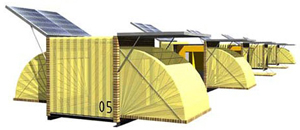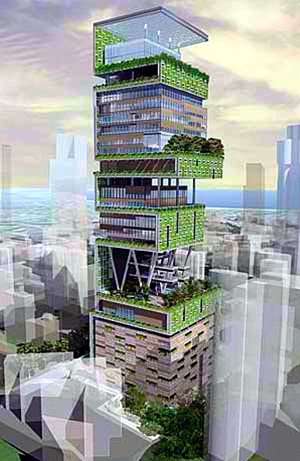COLUMNS
LEVELLING
31 August, 2011
Pills or diet?
Bioclimatic technology and sustainable simplicity.
 cartoon: Chris Madden
cartoon: Chris Madden
The story has been circulating on the web for years: In the space race of the 1960's, NASA realized that the classic pen cannot operate in space and had to find another way for astronauts to write. After several years of research and some millions of dollars, they managed to develop a pen that could put ink on paper in the absence of gravity, at high or low temperatures, while accelerating, etc. Meanwhile the Soviet cosmonauts at the same conditions were just using pencils.
This story is not entirely accurate, but it does provide a good example of simplicity and economy in solving practical problems, highlighting also the lack of common sense in the bureaucracy. Something similar can be observed in the recent green architecture, which is often attracted by new technological inventions, bypassing simple and time-proven solutions, although they offer the same benefits at less cost.
Here are some examples. The most advanced green technology of today includes new exotic materials that utilize various physicochemical properties in building construction and energy production, such as photovoltaic films with high-efficiency, low-transmittance glass, 'cold' colours that reflect heat, thermal insulation of high resistance, structural substances that bind or release heat alternating between liquid and solid phase. All these high-tech products are welcome and enrich the arsenal to improve the environmental aspects of buildings and urban space. However, they come at a cost and require special know-how in applications, thus leading to the question of whether they are suitable for widespread use or just for a few special projects.
Apart from new materials, innovations include new or 'new' construction techniques, such as green roofs, which are said to rescue us from the urban heat island effect. In the past, one would whitewash the roof or put a pergola for shade, but now these simple and modest means would not promote the country's GDP or the ecological profile of a company. So instead of putting a few more centimetres of insulation or applying a reflective paint on the desolate roof, we prefer to add extra load on the building, to pay for special waterproofing, and to regularly water the plants left at the mercy of sun and wind, just to improve the thermal conditions of the top floor. It is not easy for the benefits of the planted roof to reach the rest of the floors below, and even more so to affect the surface of the city. Is the result proportionate to the extra money, natural resources and special care that a green roof requires?
Another example is glass, a material with many advantages, but shortcomings too if used carelessly. The special types of glass we use to reduce heat flow in large glazed facades are constantly evolving, yet we might have similar thermal effects if we used simpler -and cheaper- glass in smaller openings. In other cases, we add shading elements to address overheating and glare caused by large glazing or unfavourable orientation -a remedy that some label as 'bioclimatic'. But even here we could have achieved the same result by having avoided the origin of the problem.
Photovoltaic panels and wind turbines are two other much advertised green gadgets, and since their cost is falling and subsidies rise, we are to see more and more on buildings. Sure it is good to cover our needs with renewable energy, but prior to that we should check what those needs really are, and what their main cause is. Does it make sense, say, to use electricity from the sun for incandescent lamps in empty spaces, or to add wind turbines in a glazed building that has excessive air conditioning needs?
Creating a problem with wrong design choices and then using 'bioclimatic' tricks to solve it, is not a very good example of green architecture. No doubt, we used to correct the relationship between buildings and the environment in the past too, through various mechanical means and the illusion that the energy cost is insignificant. In the recent decades we are trying to replace the energy-hungry machines with more natural mechanisms, but we overlook something fundamental on the way: that the energy and environmental performance of a building is mainly established in the early design phase, when the crucial decisions are made, such as location and orientation, general size and form (and therefore envelope-to-volume ratio), functional layout, size and distribution of openings, main structure and major materials. All you do after that is mostly to rectify or utilize the effects of our initial decisions.
Consequently, many green remedies in a building aim to mitigate problems caused by imperfect design and could have been avoided in the first place. Furthermore, several problems could be solved using more skilfully the standard building components instead of resorting to specialized green ones, as illustrated by our traditional architecture. Paradoxically, the success of a green design is the inverse of the number of special tricks used for the final goal: to harmonize user and nature.
But simple solutions, like all savings, have two disadvantages: generally they do not raise anyone's turnover, and they are discreet. Thus they defy the deities of our time, profit and showing off. In contrast, the new green products sustain a growing market, therefore it is not surprising that they are often advertised more than they probably deserve. Moreover, some of them give a semantic feature to a building, which allows promoting it to the uninformed as 'bioclimatic'.
The latter probably explains the choice of complex and expensive solutions instead of something simpler and cheaper, as the space pen and the pencil at the beginning. Quoting a developer, "A building is not enough to be green, it should also look green". In an era of superficial impressions, 'appearing' takes precedence over 'being'.
That does not mean in any way that advances in green technology are useless -quite the opposite! But it seems that so far we exploit technical progress in order to promote a not viable lifestyle rather than a truce with the planet. The emphasis on green high-tech solutions instead of 'high-sense' ones highlights the difference between 'bioclimatic' and 'sustainable'; it looks like an unrepentant gourmand who tries to lose weight by taking pills instead of dieting.
Thanos N. Stasinopoulos
Dr. Architect Engineer, AAGradDipl.
7.10.2010

Bioclimatic proposal for temporary emergency accommodation in Morocco. Each refugee shelter is equipped with expensive solar panels, inverter and batteries of questionable feasibility in a crisis situation.

Antilia Tower in Mumbai, India: One of the "15 greenest buildings in the world" 173m high, with hanging gardens and green walls. It is the residence of one family.
"The vertical gardens will help shade the building and reduce the urban heat island effect. You can use the whole wall almost like a tree and increase the green area of the site by five or 10 times over what it would be if you just did a green roof. It's a prototype for buildings of the future." [Ralph Johnson, design principal of Perkins + Will architects]
Related articles:
- The fever of the naked emperor ( 15 November, 2010 )
- After the bubble gums ( 12 September, 2010 )
- Thanos Stasinopoulos .PIRAEUS TOWER 2010 ( 08 October, 2010 )
- Barriers, barriers everywhere ( 14 December, 2010 )
- Scenarios for the future ( 10 January, 2011 )
- Parks and submarines ( 21 February, 2011 )
- The oil barrel project ( 28 April, 2011 )
- “We are animals” ( 02 June, 2011 )
- On Winds and Waters ( 11 July, 2011 )
- The Titanic ( 07 October, 2012 )










